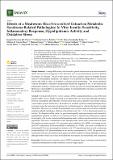Por favor, use este identificador para citar o enlazar a este item:
http://hdl.handle.net/10261/287902COMPARTIR / EXPORTAR:
 SHARE SHARE
 CORE
BASE CORE
BASE
|
|
| Visualizar otros formatos: MARC | Dublin Core | RDF | ORE | MODS | METS | DIDL | DATACITE | |

| Título: | Effects of a mealworm (Tenebrio molitor) extract on metabolic syndrome-related pathologies: In vitro insulin sensitivity, inflammatory response, hypolipidemic activity and oxidative stress |
Autor: | Navarro del Hierro, Joaquín CSIC ORCID ; Cantero-Bahillo, Emma; Fernández-Felipe, M. Teresa; García-Risco, Mónica R. CSIC ; Fornari, Tiziana CSIC ; Rada, Patricia CSIC ORCID; Doblado, Laura CSIC ORCID; Ferreira, Vítor; Hitos, Ana B. CSIC ORCID; Valverde, Ángela M. CSIC ORCID ; Monsalve, María CSIC ORCID ; Martín, Diana CSIC ORCID | Palabras clave: | Tenebrio molitor Reactive oxygen species Bioactive extract Insulin sensitivity DPPH Inflammation Pancreatic lipase Mitochondrial respiration Cholesterol |
Fecha de publicación: | 2022 | Editor: | Multidisciplinary Digital Publishing Institute | Citación: | Insects 13(10): 896 (2022) | Resumen: | The mealworm (Tenebrio molitor Linnaeus 1758) is gaining importance as one of the most popular edible insects. Studies focusing on its bioactivities are increasing, although alternative forms of consumption other than the whole insect or flour, such as bioactive non-protein extracts, remain underexplored. Furthermore, the incidence of metabolic syndrome-related pathologies keeps increasing, hence the importance of seeking novel natural sources for reducing the impact of certain risk factors. The aim was to study the potential of a non-protein mealworm extract on metabolic syndrome-related pathologies, obtained with ethanol:water (1:1, v/v) by ultrasound-assisted extraction. We characterized the extract by gas-chromatography mass-spectrometry and assessed its hypolipidemic potential, its ability to scavenger free radicals, to attenuate the inflammatory response in microglial cells, to affect mitochondrial respiration and to enhance insulin sensitivity in mouse hepatocytes. The extract contained fatty acids, monoglycerides, amino acids, certain acids and sugars. The mealworm extract caused a 30% pancreatic lipase inhibition, 80% DPPH· scavenging activity and 55.9% reduction in the bioaccessibility of cholesterol (p = 0.009). The extract was effective in decreasing iNOS levels, increasing basal, maximal and ATP coupled respiration as well as enhancing insulin-mediated AKT phosphorylation at low insulin concentrations (p < 0.05). The potential of a non-protein bioactive mealworm extract against metabolic syndrome-related pathologies is shown, although further studies are needed to elucidate the mechanisms and relationship with compounds. [Simple Summary] Among edible insects, mealworm has gained attention due to its proven beneficial effects; however, mealworm products other than flour, such as concentrated forms or extracts different to proteins, are still rare. This novel food source can have a positive impact on multiple diseases such as via the metabolic syndrome. Our objective was to describe the composition of a mealworm extract and study its effect on metabolic syndrome-related pathologies. The extract interfered with the absorption of cholesterol and partially blocked the digestion of fats. It also reduced the inflammatory response, enhanced the sensitivity to insulin and showed strong antioxidant potential. Mealworm extract might be an interesting candidate for ameliorating the risk factors associated with the metabolic syndrome. |
Descripción: | This article belongs to the Special Issue Insects as Food and Feed: Opportunities and Risks. | Versión del editor: | https://doi.org/10.3390/insects13100896 | URI: | http://hdl.handle.net/10261/287902 | DOI: | 10.3390/insects13100896 | E-ISSN: | 2075-4450 |
| Aparece en las colecciones: | (CIAL) Artículos (IIBM) Artículos |
Ficheros en este ítem:
| Fichero | Descripción | Tamaño | Formato | |
|---|---|---|---|---|
| effectstress.pdf | 2,34 MB | Adobe PDF |  Visualizar/Abrir |
CORE Recommender
Page view(s)
48
checked on 18-abr-2024
Download(s)
97
checked on 18-abr-2024
Google ScholarTM
Check
Altmetric
Altmetric
Este item está licenciado bajo una Licencia Creative Commons

